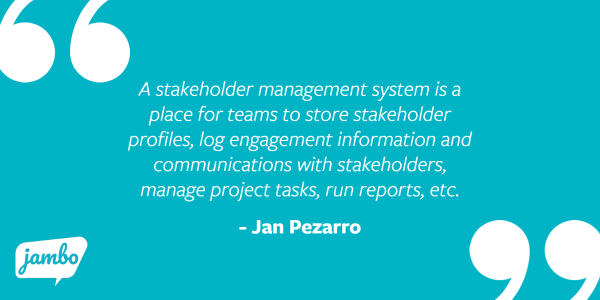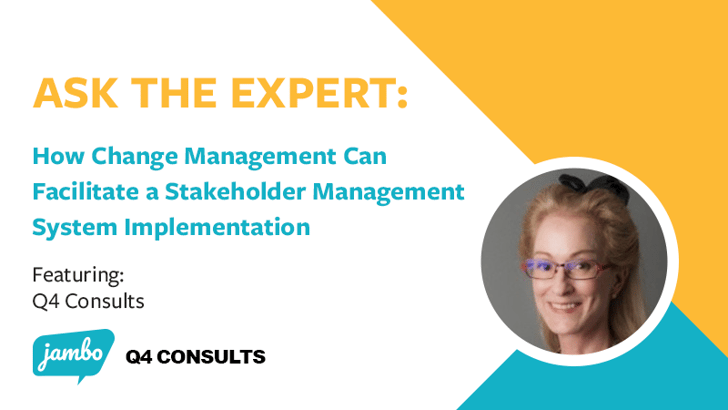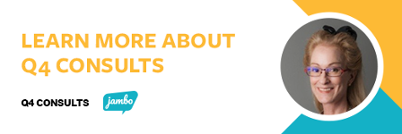Joining Jambo today for this Q&A blog is Jan Pezarro from Q4 Consults. Q4 Consults focus on strategic planning, communications and engagement, and corporate development. As Jan says, “this might seem like a little bit of an unusual mix until you consider that communications and engagement and corporate development are crucial to the implementation of any strategic plan.” For Jan’s bio and the rest of the Q4 Consults team bios, please visit the Q4 Consults website.
We asked Jan to join our expert blog series to provide our readers with some insight into how change management best practices can be used by engagement teams to improve stakeholder management system implementations. Jan’s change management expertise lies largely in the transportation industry including railways, transit, ports, airports - just about anything that involves the movement of people and goods. She has most recently guided a change management process within the health sector. “When it comes to change management, very different industries experience the same issues,” says Jan.
Q. What is change management?
In its simplest form, change management is a systematic approach that helps the implementation of new initiatives by supporting all the stakeholders impacted by the change. It proposes a range of strategies and tactics that will drive the adoption of the desired change. It considers policy, equipment, software, resources, and people.
Q. Why is change management important for engagement teams?

People working in the engagement space often consider stakeholders to be the individuals impacted by a project and with whom they are doing the engagement or consultation. For this blog, we are considering internal stakeholders - the team members that will be directly impacted by the new process and technology. Like external stakeholders, internal stakeholders can advance or delay the completion of a project.
We know that moving from one way of managing stakeholder engagement to another will be a change, so you need to include all members of the team in the implementation journey so they can feel confident using the new software. If a team member doesn’t understand why they are using new software or isn’t taught how to use all the excellent features, it is unlikely they will buy into the change.
If implemented effectively, the outcome of a stakeholder management system implementation is that engagement teams can transform how they run their stakeholder engagement programs and improve their stakeholder relationships.
Q. How do engagement teams get started with a change management plan?
I suggest beginning by asking these questions:
- Who are the stakeholders (both internal and external)?
- What are their needs?
- What are the objectives of the project?
- What are the key principles and key messages?
- Where are the gaps?
- How can we bridge those gaps?
You need to understand the answers to these questions so, when you roll out your software implementation, everyone is singing from the same hymn sheet. To do this, meet with executives, the engagement teams, external stakeholders (if appropriate and applicable), the software provider and whoever else makes sense. Take all their input and use it to answer the questions and produce your change management plan.
In large-scale implementations, there’s often so much attention paid to aspects like documentation or the timeline for implementation, that organizations forget about the people at the front line who are actually going to use the software and drive the change. Believe me, it’s way easier to do your research and work with team members in advance than to launch your new software and fail due to lack of adoption.
Q. What change management tips do you have for engagement teams implementing a software management system?

For engagement teams communicating with many stakeholders or running consultation activities that need to be reported on, not using software to organize and manage this information is a significant risk. A stakeholder management system is a place for teams to store stakeholder profiles, log engagement information and communications with stakeholders, manage project tasks, run reports, etc.
I suggest helping people understand both the benefits of the software and the risks involved if the software isn’t implemented. Develop key messages that explain these risks and use them often. It can be helpful to designate a champion of the software implementation to help get these messages across.
“Change management is a systematic approach where we must assess the readiness of each team member on a couple of metrics to embrace and succeed with the new process or technology.”
A change management tool you can use during the implementation phase is a readiness assessment. A readiness assessment identifies the potential challenges that might arise when implementing the new software within a current organizational context. It helps by getting under the hood to understand how people feel and the attitudes they have towards the change. You can find out things like:
- Do they understand the need for the new software?
- Do they have previous experiences with software implementations (good and bad)?
- How do they feel about learning the new software? Are there any concerns?
- Do they have time to learn the new software? If they don’t, how can you help free up their time?
- Do they understand the risks of not implementing or using the software?
Only when you tease out those individual aspects and concerns can you understand the challenges you may face during the implementation. Once you have completed a readiness assessment, you can start to think about what needs to be done to address these challenges.
For example, if someone is concerned about learning how to use the new software or is worried that they won’t understand it, consider if there is someone on your team who is a software wiz and buddy them up for peer support or coaching. Peer support is judgement-free and can help teams move towards the successful adoption of new software.











